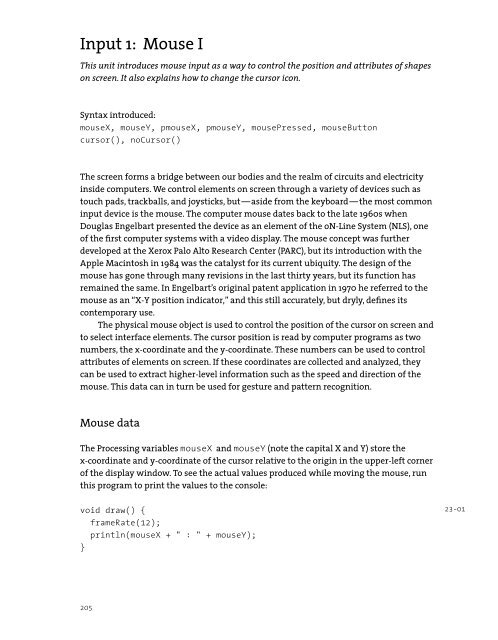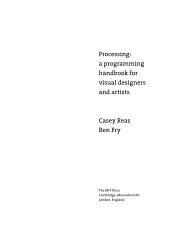Fractal.Invaders, Substrate (Interview with Jared Tarbell) - Processing
Fractal.Invaders, Substrate (Interview with Jared Tarbell) - Processing
Fractal.Invaders, Substrate (Interview with Jared Tarbell) - Processing
Create successful ePaper yourself
Turn your PDF publications into a flip-book with our unique Google optimized e-Paper software.
Input 1: Mouse I<br />
This unit introduces mouse input as a way to control the position and attributes of shapes<br />
on screen. It also explains how to change the cursor icon.<br />
Syntax introduced:<br />
mouseX, mouseY, pmouseX, pmouseY, mousePressed, mouseButton<br />
cursor(), noCursor()<br />
The screen forms a bridge between our bodies and the realm of circuits and electricity<br />
inside computers. We control elements on screen through a variety of devices such as<br />
touch pads, trackballs, and joysticks, but—aside from the keyboard—the most common<br />
input device is the mouse. The computer mouse dates back to the late 1960s when<br />
Douglas Engelbart presented the device as an element of the oN-Line System (NLS), one<br />
of the fi rst computer systems <strong>with</strong> a video display. The mouse concept was further<br />
developed at the Xerox Palo Alto Research Center (PARC), but its introduction <strong>with</strong> the<br />
Apple Macintosh in 1984 was the catalyst for its current ubiquity. The design of the<br />
mouse has gone through many revisions in the last thirty years, but its function has<br />
remained the same. In Engelbart’s original patent application in 1970 he referred to the<br />
mouse as an “X-Y position indicator,” and this still accurately, but dryly, defi nes its<br />
contemporary use.<br />
The physical mouse object is used to control the position of the cursor on screen and<br />
to select interface elements. The cursor position is read by computer programs as two<br />
numbers, the x-coordinate and the y-coordinate. These numbers can be used to control<br />
attributes of elements on screen. If these coordinates are collected and analyzed, they<br />
can be used to extract higher-level information such as the speed and direction of the<br />
mouse. This data can in turn be used for gesture and pattern recognition.<br />
Mouse data<br />
The <strong>Processing</strong> variables mouseX and mouseY (note the capital X and Y) store the<br />
x-coordinate and y-coordinate of the cursor relative to the origin in the upper-left corner<br />
of the display window. To see the actual values produced while moving the mouse, run<br />
this program to print the values to the console:<br />
void draw() {<br />
frameRate(12);<br />
println(mouseX + " : " + mouseY);<br />
}<br />
205<br />
23-01



